2007 ISUZU KB P190 ECO mode
[x] Cancel search: ECO modePage 1748 of 6020
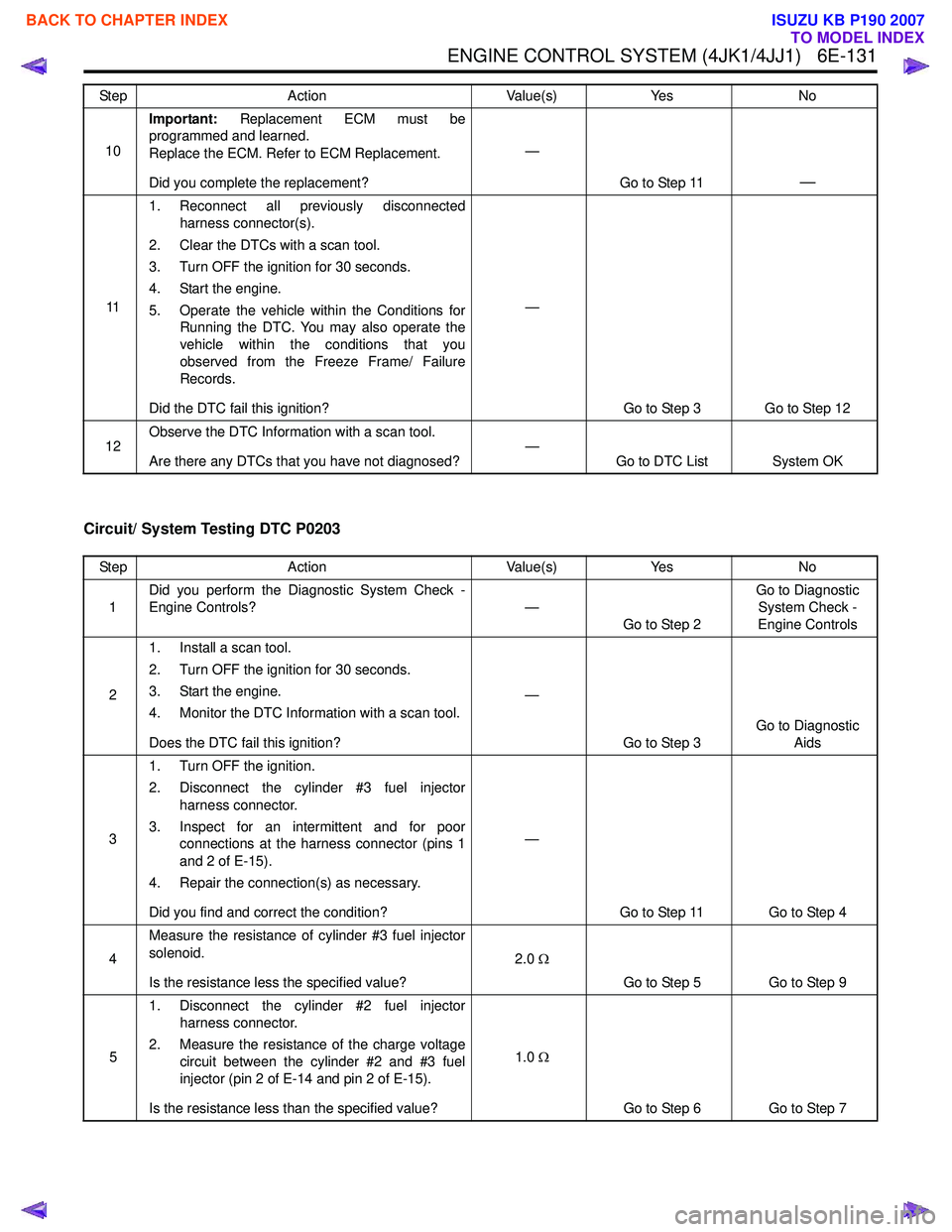
ENGINE CONTROL SYSTEM (4JK1/4JJ1) 6E-131
Circuit/ System Testing DTC P0203
10Important:
Replacement ECM must be
programmed and learned.
Replace the ECM. Refer to ECM Replacement.
Did you complete the replacement? —
Go to Step 11
—
111. Reconnect all previously disconnected
harness connector(s).
2. Clear the DTCs with a scan tool.
3. Turn OFF the ignition for 30 seconds.
4. Start the engine.
5. Operate the vehicle within the Conditions for Running the DTC. You may also operate the
vehicle within the conditions that you
observed from the Freeze Frame/ Failure
Records.
Did the DTC fail this ignition? —
Go to Step 3 Go to Step 12
12 Observe the DTC Information with a scan tool.
Are there any DTCs that you have not diagnosed? —
Go to DTC List System OK
Step
Action Value(s)Yes No
Step Action Value(s)Yes No
1 Did you perform the Diagnostic System Check -
Engine Controls? —
Go to Step 2 Go to Diagnostic
System Check -
Engine Controls
2 1. Install a scan tool.
2. Turn OFF the ignition for 30 seconds.
3. Start the engine.
4. Monitor the DTC Information with a scan tool.
Does the DTC fail this ignition? —
Go to Step 3 Go to Diagnostic
Aids
3 1. Turn OFF the ignition.
2. Disconnect the cylinder #3 fuel injector harness connector.
3. Inspect for an intermittent and for poor connections at the harness connector (pins 1
and 2 of E-15).
4. Repair the connection(s) as necessary.
Did you find and correct the condition? —
Go to Step 11 Go to Step 4
4 Measure the resistance of cylinder #3 fuel injector
solenoid.
Is the resistance less the specified value? 2.0
Ω
Go to Step 5 Go to Step 9
5 1. Disconnect the cylinder #2 fuel injector
harness connector.
2. Measure the resistance of the charge voltage circuit between the cylinder #2 and #3 fuel
injector (pin 2 of E-14 and pin 2 of E-15).
Is the resistance less than the specified value? 1.0
Ω
Go to Step 6 Go to Step 7
BACK TO CHAPTER INDEX
TO MODEL INDEX
ISUZU KB P190 2007
Page 1749 of 6020
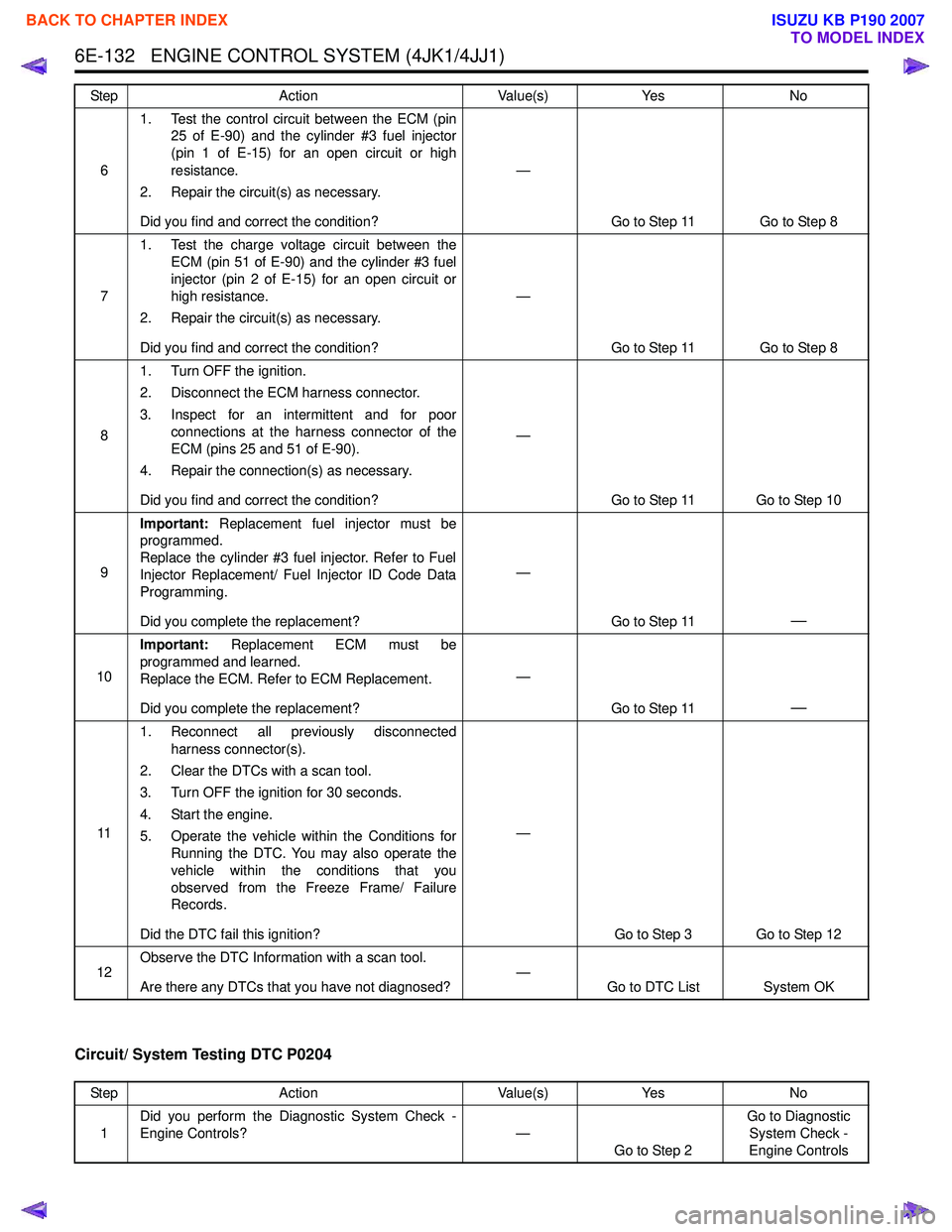
6E-132 ENGINE CONTROL SYSTEM (4JK1/4JJ1)
Circuit/ System Testing DTC P0204
61. Test the control circuit between the ECM (pin
25 of E-90) and the cylinder #3 fuel injector
(pin 1 of E-15) for an open circuit or high
resistance.
2. Repair the circuit(s) as necessary.
Did you find and correct the condition? —
Go to Step 11 Go to Step 8
7 1. Test the charge voltage circuit between the
ECM (pin 51 of E-90) and the cylinder #3 fuel
injector (pin 2 of E-15) for an open circuit or
high resistance.
2. Repair the circuit(s) as necessary.
Did you find and correct the condition? —
Go to Step 11 Go to Step 8
8 1. Turn OFF the ignition.
2. Disconnect the ECM harness connector.
3. Inspect for an intermittent and for poor connections at the harness connector of the
ECM (pins 25 and 51 of E-90).
4. Repair the connection(s) as necessary.
Did you find and correct the condition? —
Go to Step 11 Go to Step 10
9 Important:
Replacement fuel injector must be
programmed.
Replace the cylinder #3 fuel injector. Refer to Fuel
Injector Replacement/ Fuel Injector ID Code Data
Programming.
Did you complete the replacement? —
Go to Step 11
—
10Important:
Replacement ECM must be
programmed and learned.
Replace the ECM. Refer to ECM Replacement.
Did you complete the replacement? —
Go to Step 11
—
111. Reconnect all previously disconnected
harness connector(s).
2. Clear the DTCs with a scan tool.
3. Turn OFF the ignition for 30 seconds.
4. Start the engine.
5. Operate the vehicle within the Conditions for Running the DTC. You may also operate the
vehicle within the conditions that you
observed from the Freeze Frame/ Failure
Records.
Did the DTC fail this ignition? —
Go to Step 3 Go to Step 12
12 Observe the DTC Information with a scan tool.
Are there any DTCs that you have not diagnosed? —
Go to DTC List System OK
Step
Action Value(s)Yes No
Step Action Value(s)Yes No
1 Did you perform the Diagnostic System Check -
Engine Controls? —
Go to Step 2 Go to Diagnostic
System Check -
Engine Controls
BACK TO CHAPTER INDEX
TO MODEL INDEX
ISUZU KB P190 2007
Page 1750 of 6020
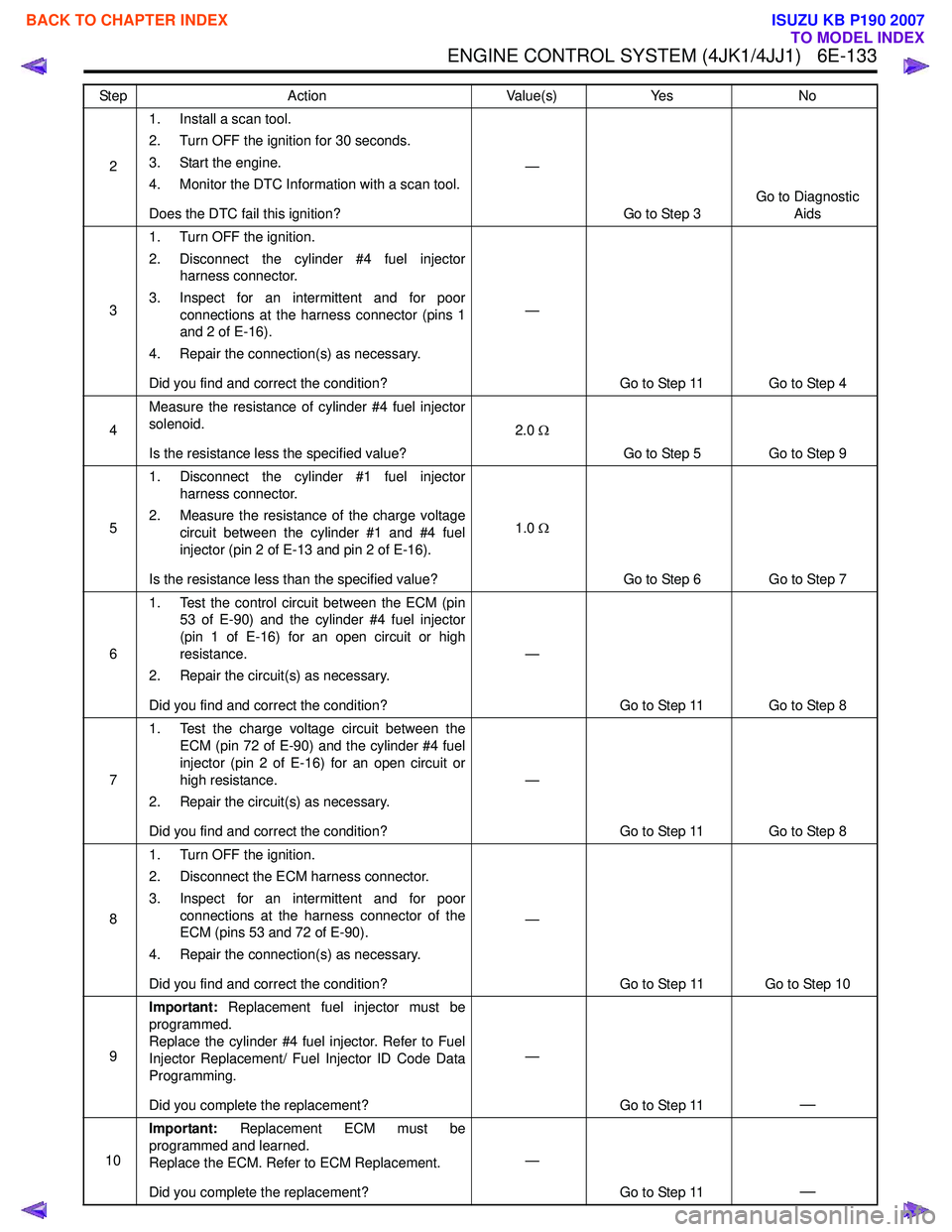
ENGINE CONTROL SYSTEM (4JK1/4JJ1) 6E-133
21. Install a scan tool.
2. Turn OFF the ignition for 30 seconds.
3. Start the engine.
4. Monitor the DTC Information with a scan tool.
Does the DTC fail this ignition? —
Go to Step 3 Go to Diagnostic
Aids
3 1. Turn OFF the ignition.
2. Disconnect the cylinder #4 fuel injector harness connector.
3. Inspect for an intermittent and for poor connections at the harness connector (pins 1
and 2 of E-16).
4. Repair the connection(s) as necessary.
Did you find and correct the condition? —
Go to Step 11 Go to Step 4
4 Measure the resistance of cylinder #4 fuel injector
solenoid.
Is the resistance less the specified value? 2.0
Ω
Go to Step 5 Go to Step 9
5 1. Disconnect the cylinder #1 fuel injector
harness connector.
2. Measure the resistance of the charge voltage circuit between the cylinder #1 and #4 fuel
injector (pin 2 of E-13 and pin 2 of E-16).
Is the resistance less than the specified value? 1.0
Ω
Go to Step 6 Go to Step 7
6 1. Test the control circuit between the ECM (pin
53 of E-90) and the cylinder #4 fuel injector
(pin 1 of E-16) for an open circuit or high
resistance.
2. Repair the circuit(s) as necessary.
Did you find and correct the condition? —
Go to Step 11 Go to Step 8
7 1. Test the charge voltage circuit between the
ECM (pin 72 of E-90) and the cylinder #4 fuel
injector (pin 2 of E-16) for an open circuit or
high resistance.
2. Repair the circuit(s) as necessary.
Did you find and correct the condition? —
Go to Step 11 Go to Step 8
8 1. Turn OFF the ignition.
2. Disconnect the ECM harness connector.
3. Inspect for an intermittent and for poor connections at the harness connector of the
ECM (pins 53 and 72 of E-90).
4. Repair the connection(s) as necessary.
Did you find and correct the condition? —
Go to Step 11 Go to Step 10
9 Important:
Replacement fuel injector must be
programmed.
Replace the cylinder #4 fuel injector. Refer to Fuel
Injector Replacement/ Fuel Injector ID Code Data
Programming.
Did you complete the replacement? —
Go to Step 11
—
10Important:
Replacement ECM must be
programmed and learned.
Replace the ECM. Refer to ECM Replacement.
Did you complete the replacement? —
Go to Step 11
—
Step Action Value(s)Yes No
BACK TO CHAPTER INDEX
TO MODEL INDEX
ISUZU KB P190 2007
Page 1751 of 6020
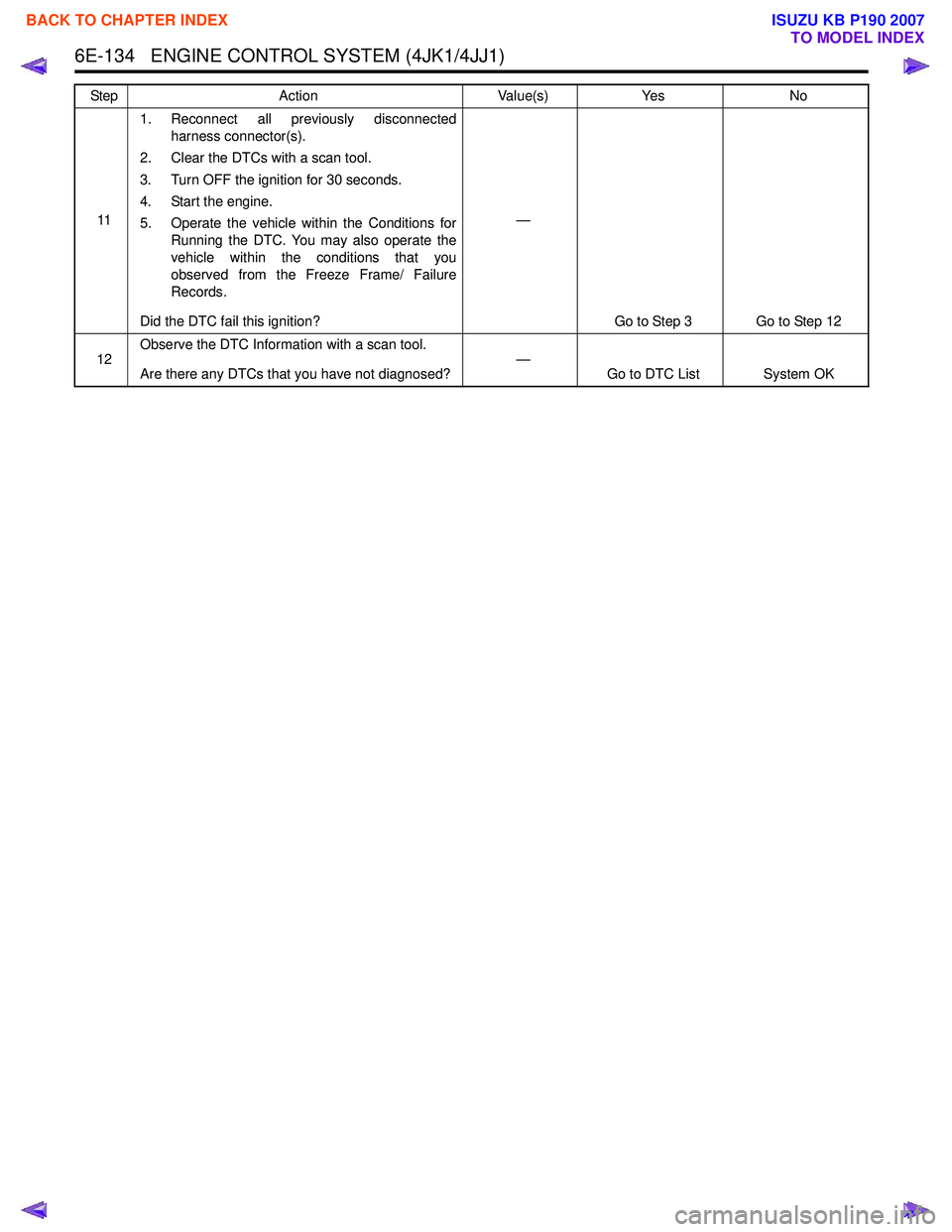
6E-134 ENGINE CONTROL SYSTEM (4JK1/4JJ1)
111. Reconnect all previously disconnected
harness connector(s).
2. Clear the DTCs with a scan tool.
3. Turn OFF the ignition for 30 seconds.
4. Start the engine.
5. Operate the vehicle within the Conditions for Running the DTC. You may also operate the
vehicle within the conditions that you
observed from the Freeze Frame/ Failure
Records.
Did the DTC fail this ignition? —
Go to Step 3 Go to Step 12
12 Observe the DTC Information with a scan tool.
Are there any DTCs that you have not diagnosed? —
Go to DTC List System OK
Step
Action Value(s)Yes No
BACK TO CHAPTER INDEX
TO MODEL INDEX
ISUZU KB P190 2007
Page 1752 of 6020
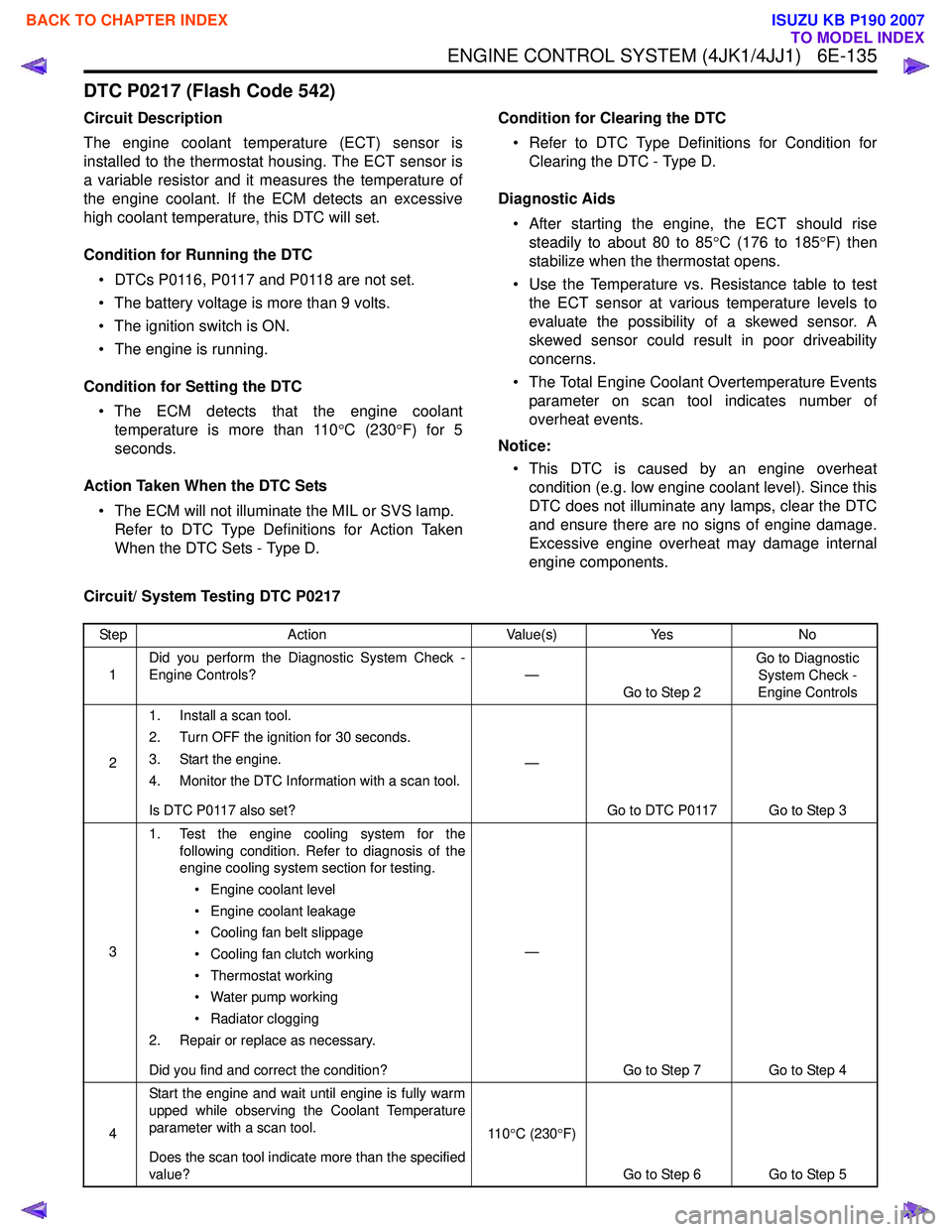
ENGINE CONTROL SYSTEM (4JK1/4JJ1) 6E-135
DTC P0217 (Flash Code 542)
Circuit Description
The engine coolant temperature (ECT) sensor is
installed to the thermostat housing. The ECT sensor is
a variable resistor and it measures the temperature of
the engine coolant. If the ECM detects an excessive
high coolant temperature, this DTC will set.
Condition for Running the DTC • DTCs P0116, P0117 and P0118 are not set.
• The battery voltage is more than 9 volts.
• The ignition switch is ON.
• The engine is running.
Condition for Setting the DTC • The ECM detects that the engine coolant temperature is more than 110 °C (230 °F) for 5
seconds.
Action Taken When the DTC Sets • The ECM will not illuminate the MIL or SVS lamp. Refer to DTC Type Definitions for Action Taken
When the DTC Sets - Type D. Condition for Clearing the DTC
• Refer to DTC Type Definitions for Condition for Clearing the DTC - Type D.
Diagnostic Aids • After starting the engine, the ECT should rise steadily to about 80 to 85 °C (176 to 185 °F) then
stabilize when the thermostat opens.
• Use the Temperature vs. Resistance table to test the ECT sensor at various temperature levels to
evaluate the possibility of a skewed sensor. A
skewed sensor could result in poor driveability
concerns.
• The Total Engine Coolant Overtemperature Events parameter on scan tool indicates number of
overheat events.
Notice: • This DTC is caused by an engine overheat condition (e.g. low engine coolant level). Since this
DTC does not illuminate any lamps, clear the DTC
and ensure there are no signs of engine damage.
Excessive engine overheat may damage internal
engine components.
Circuit/ System Testing DTC P0217
Step Action Value(s)Yes No
1 Did you perform the Diagnostic System Check -
Engine Controls? —
Go to Step 2 Go to Diagnostic
System Check -
Engine Controls
2 1. Install a scan tool.
2. Turn OFF the ignition for 30 seconds.
3. Start the engine.
4. Monitor the DTC Information with a scan tool.
Is DTC P0117 also set? —
Go to DTC P0117 Go to Step 3
3 1. Test the engine cooling system for the
following condition. Refer to diagnosis of the
engine cooling system section for testing.
• Engine coolant level
• Engine coolant leakage
• Cooling fan belt slippage
• Cooling fan clutch working
• Thermostat working
• Water pump working
• Radiator clogging
2. Repair or replace as necessary.
Did you find and correct the condition? —
Go to Step 7 Go to Step 4
4 Start the engine and wait until engine is fully warm
upped while observing the Coolant Temperature
parameter with a scan tool.
Does the scan tool indicate more than the specified
value? 11 0
°C (230 °F)
Go to Step 6 Go to Step 5
BACK TO CHAPTER INDEX
TO MODEL INDEX
ISUZU KB P190 2007
Page 1753 of 6020
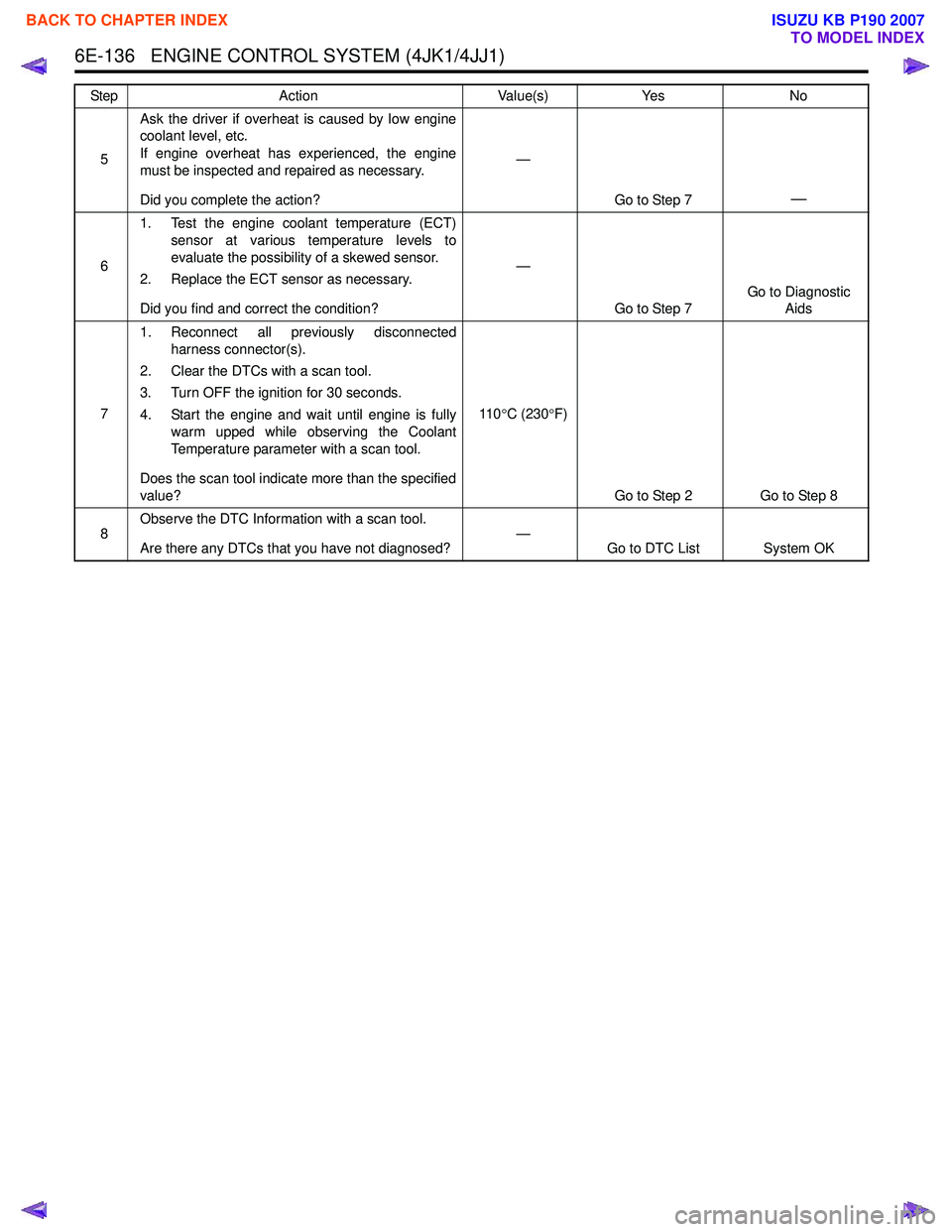
6E-136 ENGINE CONTROL SYSTEM (4JK1/4JJ1)
5Ask the driver if overheat is caused by low engine
coolant level, etc.
If engine overheat has experienced, the engine
must be inspected and repaired as necessary.
Did you complete the action? —
Go to Step 7
—
61. Test the engine coolant temperature (ECT)
sensor at various temperature levels to
evaluate the possibility of a skewed sensor.
2. Replace the ECT sensor as necessary.
Did you find and correct the condition? —
Go to Step 7 Go to Diagnostic
Aids
7 1. Reconnect all previously disconnected
harness connector(s).
2. Clear the DTCs with a scan tool.
3. Turn OFF the ignition for 30 seconds.
4. Start the engine and wait until engine is fully warm upped while observing the Coolant
Temperature parameter with a scan tool.
Does the scan tool indicate more than the specified
value? 11 0
°C (230 °F)
Go to Step 2 Go to Step 8
8 Observe the DTC Information with a scan tool.
Are there any DTCs that you have not diagnosed? —
Go to DTC List System OK
Step
Action Value(s)Yes No
BACK TO CHAPTER INDEX
TO MODEL INDEX
ISUZU KB P190 2007
Page 1754 of 6020
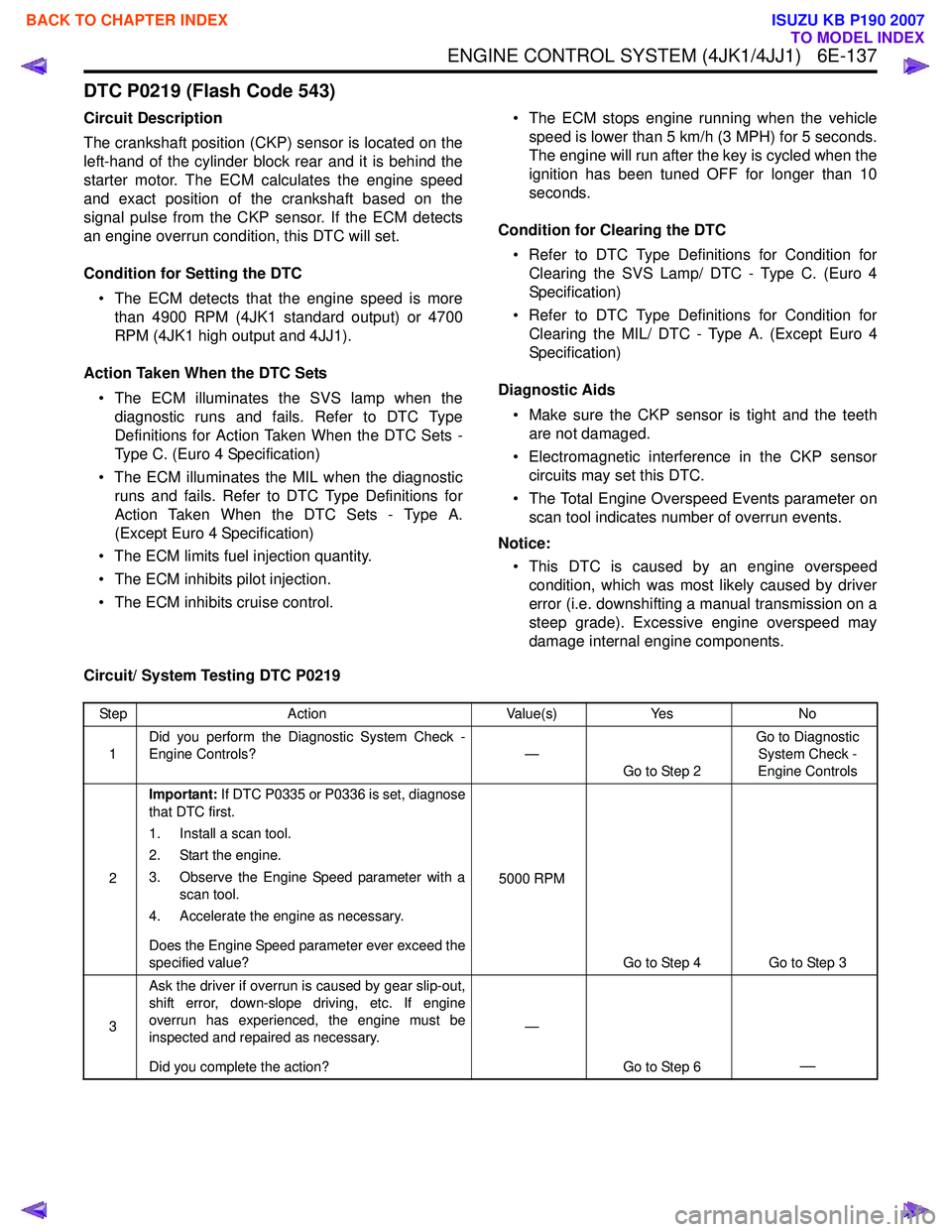
ENGINE CONTROL SYSTEM (4JK1/4JJ1) 6E-137
DTC P0219 (Flash Code 543)
Circuit Description
The crankshaft position (CKP) sensor is located on the
left-hand of the cylinder block rear and it is behind the
starter motor. The ECM calculates the engine speed
and exact position of the crankshaft based on the
signal pulse from the CKP sensor. If the ECM detects
an engine overrun condition, this DTC will set.
Condition for Setting the DTC • The ECM detects that the engine speed is more than 4900 RPM (4JK1 standard output) or 4700
RPM (4JK1 high output and 4JJ1).
Action Taken When the DTC Sets • The ECM illuminates the SVS lamp when the diagnostic runs and fails. Refer to DTC Type
Definitions for Action Taken When the DTC Sets -
Type C. (Euro 4 Specification)
• The ECM illuminates the MIL when the diagnostic runs and fails. Refer to DTC Type Definitions for
Action Taken When the DTC Sets - Type A.
(Except Euro 4 Specification)
• The ECM limits fuel injection quantity.
• The ECM inhibits pilot injection.
• The ECM inhibits cruise control. • The ECM stops engine running when the vehicle
speed is lower than 5 km/h (3 MPH) for 5 seconds.
The engine will run after the key is cycled when the
ignition has been tuned OFF for longer than 10
seconds.
Condition for Clearing the DTC • Refer to DTC Type Definitions for Condition for Clearing the SVS Lamp/ DTC - Type C. (Euro 4
Specification)
• Refer to DTC Type Definitions for Condition for Clearing the MIL/ DTC - Type A. (Except Euro 4
Specification)
Diagnostic Aids • Make sure the CKP sensor is tight and the teeth are not damaged.
• Electromagnetic interference in the CKP sensor circuits may set this DTC.
• The Total Engine Overspeed Events parameter on scan tool indicates number of overrun events.
Notice: • This DTC is caused by an engine overspeed condition, which was most likely caused by driver
error (i.e. downshifting a manual transmission on a
steep grade). Excessive engine overspeed may
damage internal engine components.
Circuit/ System Testing DTC P0219
Step Action Value(s)Yes No
1 Did you perform the Diagnostic System Check -
Engine Controls? —
Go to Step 2 Go to Diagnostic
System Check -
Engine Controls
2 Important:
If DTC P0335 or P0336 is set, diagnose
that DTC first.
1. Install a scan tool.
2. Start the engine.
3. Observe the Engine Speed parameter with a scan tool.
4. Accelerate the engine as necessary.
Does the Engine Speed parameter ever exceed the
specified value? 5000 RPM
Go to Step 4 Go to Step 3
3 Ask the driver if overrun is caused by gear slip-out,
shift error, down-slope driving, etc. If engine
overrun has experienced, the engine must be
inspected and repaired as necessary.
Did you complete the action? —
Go to Step 6
—
BACK TO CHAPTER INDEX
TO MODEL INDEX
ISUZU KB P190 2007
Page 1755 of 6020
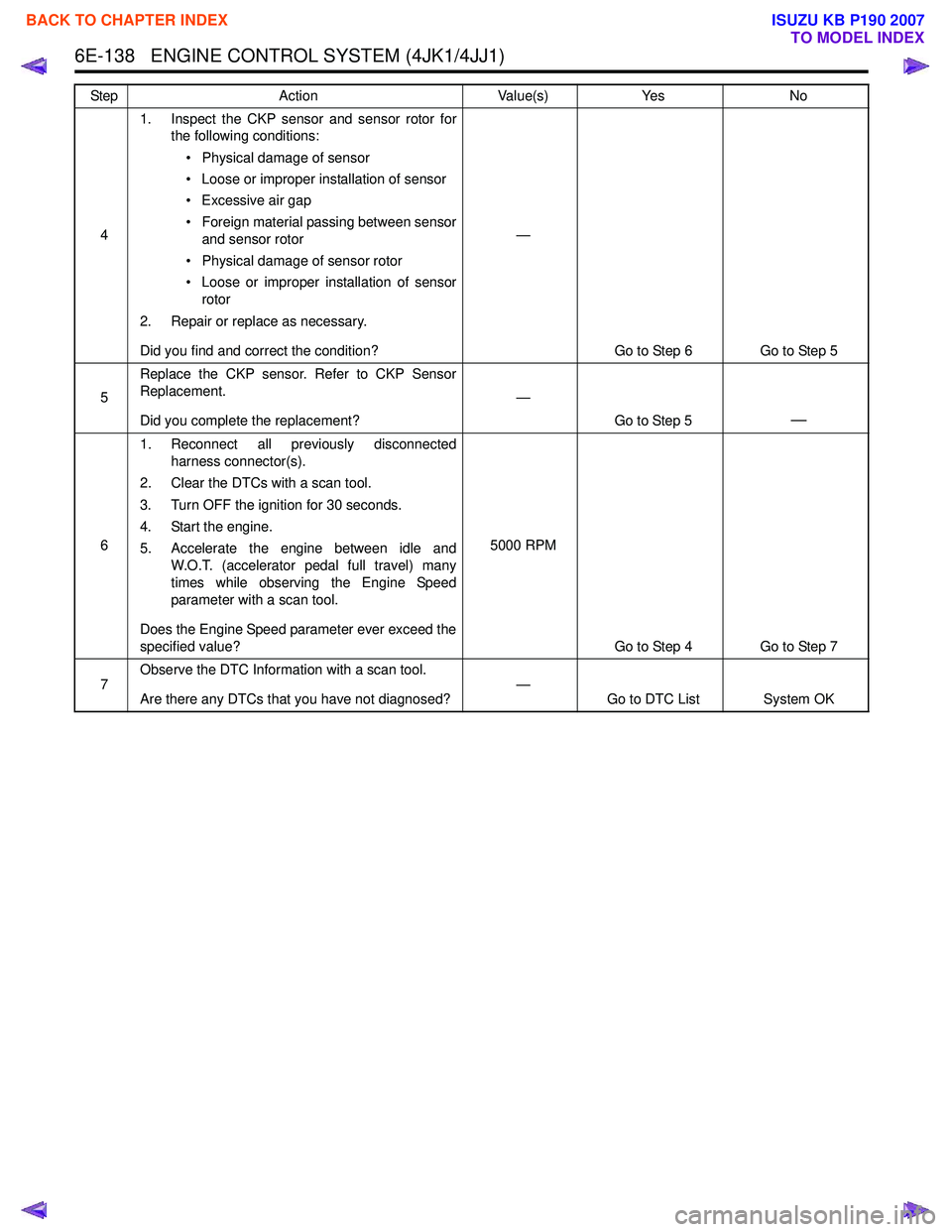
6E-138 ENGINE CONTROL SYSTEM (4JK1/4JJ1)
41. Inspect the CKP sensor and sensor rotor for
the following conditions:
• Physical damage of sensor
• Loose or improper installation of sensor
• Excessive air gap
• Foreign material passing between sensor and sensor rotor
• Physical damage of sensor rotor
• Loose or improper installation of sensor rotor
2. Repair or replace as necessary.
Did you find and correct the condition? —
Go to Step 6 Go to Step 5
5 Replace the CKP sensor. Refer to CKP Sensor
Replacement.
Did you complete the replacement? —
Go to Step 5
—
61. Reconnect all previously disconnected
harness connector(s).
2. Clear the DTCs with a scan tool.
3. Turn OFF the ignition for 30 seconds.
4. Start the engine.
5. Accelerate the engine between idle and W.O.T. (accelerator pedal full travel) many
times while observing the Engine Speed
parameter with a scan tool.
Does the Engine Speed parameter ever exceed the
specified value? 5000 RPM
Go to Step 4 Go to Step 7
7 Observe the DTC Information with a scan tool.
Are there any DTCs that you have not diagnosed? —
Go to DTC List System OK
Step
Action Value(s)Yes No
BACK TO CHAPTER INDEX
TO MODEL INDEX
ISUZU KB P190 2007